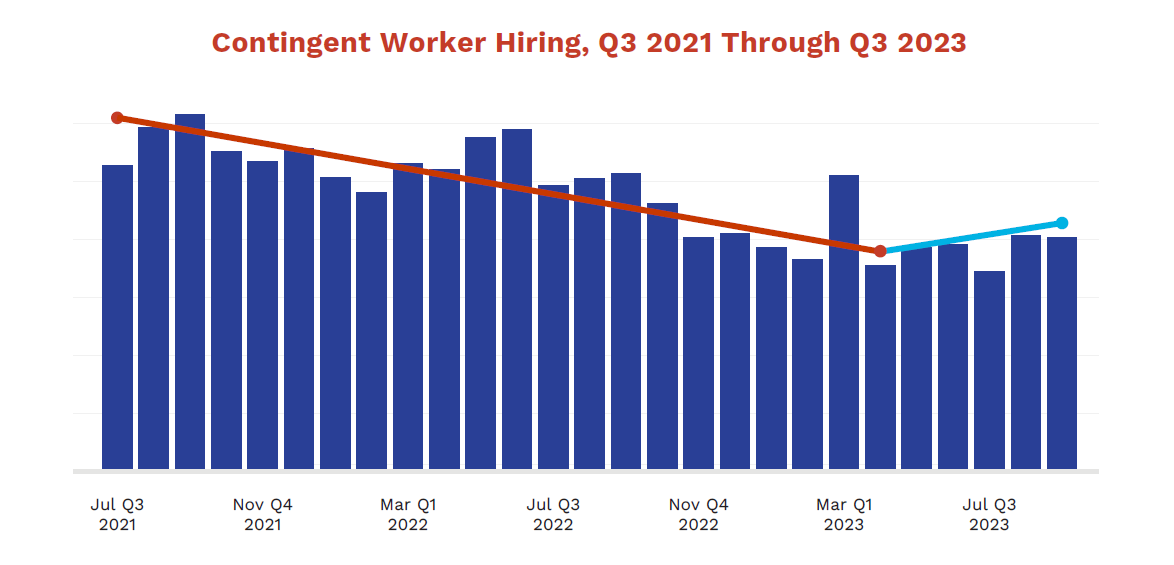Key Takeaways & Trends: Winter 2023-24 U.S. Labor Market Report
Dustin Burgess December 8 2023

The U.S. labor market has gone through various shifts in 2023 as it has recovered from the effects of the pandemic. While unemployment rates have returned to pre-pandemic levels, the labor market is still experiencing labor shortages, various wage disparities and remote work decisions. As job dynamics continue to shift and the workforce evolves, organizations will need to stay on top of these trends and developments so they can fully optimize their workforce.
In this blog post we’re going to cover four major takeaways derived from Magnit’s Winter 2023-25 U.S. Labor Market Report, which touch on the U.S. economy, voluntary terminations, layoffs and the growing demand for Artificial Intelligence (AI) skills.
1. The U.S. Economy Appears Poised for an Upswing
Data sourced from our latest labor market report, which includes hiring, attrition, layoffs, and a variety of other data elements suggests there may be a positive change in direction for the U.S. economy in 2024.

Organizations can effectively prepare for the uncertainty, along with this potential uptick by assessing and optimizing their use of the extended workforce to maximize flexibility in the year ahead. In addition, implementing other sophisticated measures such as holistic total talent planning and worker redeployment strategies can further strengthen their advantage in the war for talent. Tapping real-time global market data will also enable organizations to engage the best talent in the most effective markets at the best price, which will help ensure they’re allocating resources strategically – even in a volatile market.
2. Voluntary Terminations Are Increasing
In early 2023, voluntary terminations reached a three-year low but have risen since. This is especially important because this data point typically mirrors hiring volumes; as hiring decreases, voluntary terminations similarly diminish. As the economy stabilizes and companies begin to rebound, we will likely see voluntary terms continue to rise as the workforce feels more confident in exploring new opportunities with new organizations. Organizations should act now and invest resources to help sure up worker retention, including re-evaluating the worker experience to find areas of improvement, or they could risk seeing key talent walk out the door. Learn more about the importance of providing an excellent candidate experience in our infographic and how worker experience can serve as an advantage in the war for talent in our blog.
3. Organizations Should Rethink Their Approach to Layoffs
Through the recent economic volatility, our data reveals that while certain industries have laid off workers, a major portion of that workforce was rebuilt within the same year. To help avoid the layoff/rehire cycle and its related negative consequences (including increases in hiring costs and decreases in efficiency, brand power, and employee loyalty), organizations should approach workforce planning with a long-term, strategic mindset. As part of this exercise, they should also look internally to evaluate where they can upskill existing workers and reallocate work. Further, the flexibility that comes with contingent work allows for more flexibility than committing to full-time hires. Learn more about key steps for deploying skills-based hiring in our blog post.
4. Demand for AI Skills is Rising
AI skills and demand for AI roles spread from their IT/technology silos to other fields for the first time in 2023, including engineering/operations and accounting/finance. The increase in AI demand is exemplified in the changes in recent years for contingent software engineer job descriptions. According to Magnit data, only 0.5% of these roles referenced AI from 2019 to 2021. In 2022, however, that figure leaped to 2.6% with the rise of ChatGPT and to 3.3% with the introduction of Microsoft’s Bing Chat and Google’s Bard in 2023. Magnit data also estimates that by 2024, this figure could nearly double to 6%.

As the landscape continues to evolve rapidly, organizations that embrace a skills-based hiring approach will be able to find AI talent easier, since these skills are still new and may not be evident based on candidates’ education history or past job titles. In fact, a significant portion of the workforce is taking the initiative to upskill themselves with publicly AI-training courses as the technologies are evolving so rapidly.
For more proven strategies on optimizing your talent supply chain, download the full Winter 2023-24 U.S. Labor Market Report now.
Disclaimer: The content in this blog post is for informational purposes only and cannot be construed as specific legal advice or as a substitute for legal advice. The blog post reflects the opinion of Magnit and is not to be construed as legal solutions and positions. Contact an attorney for specific advice and guidance for specific issues or questions.
